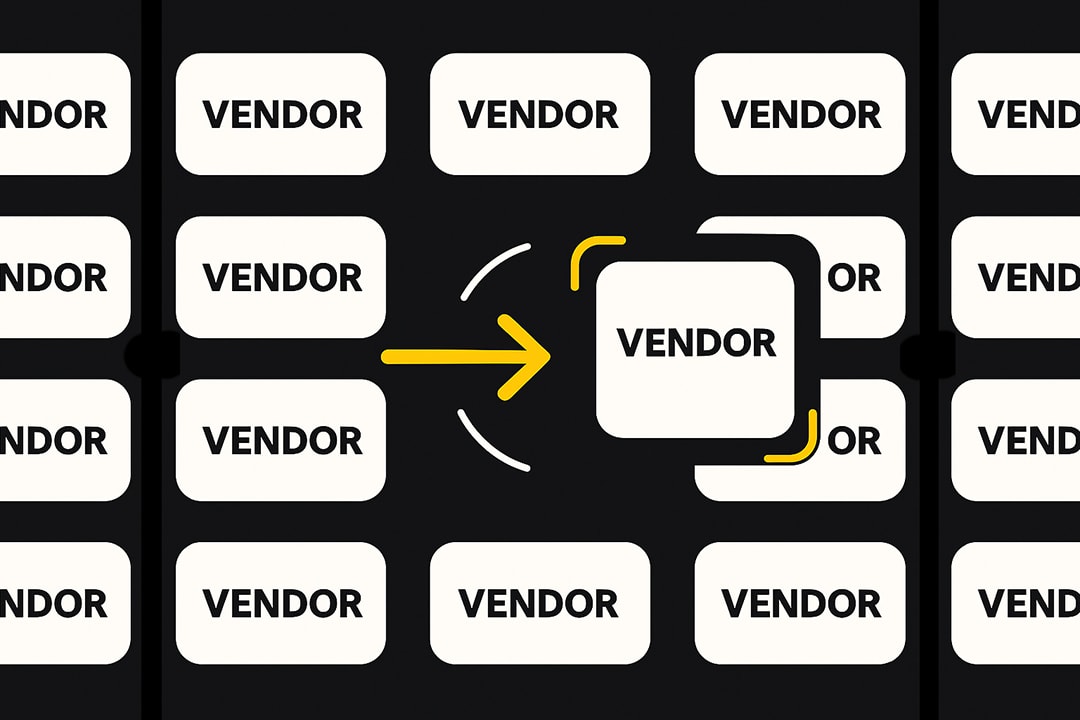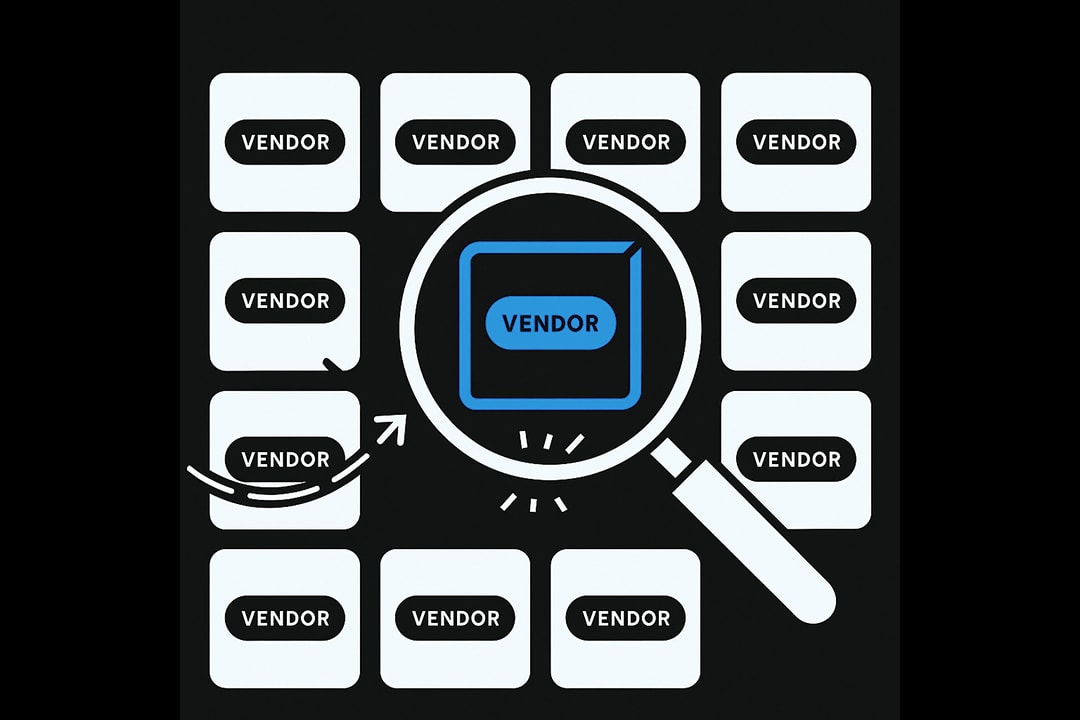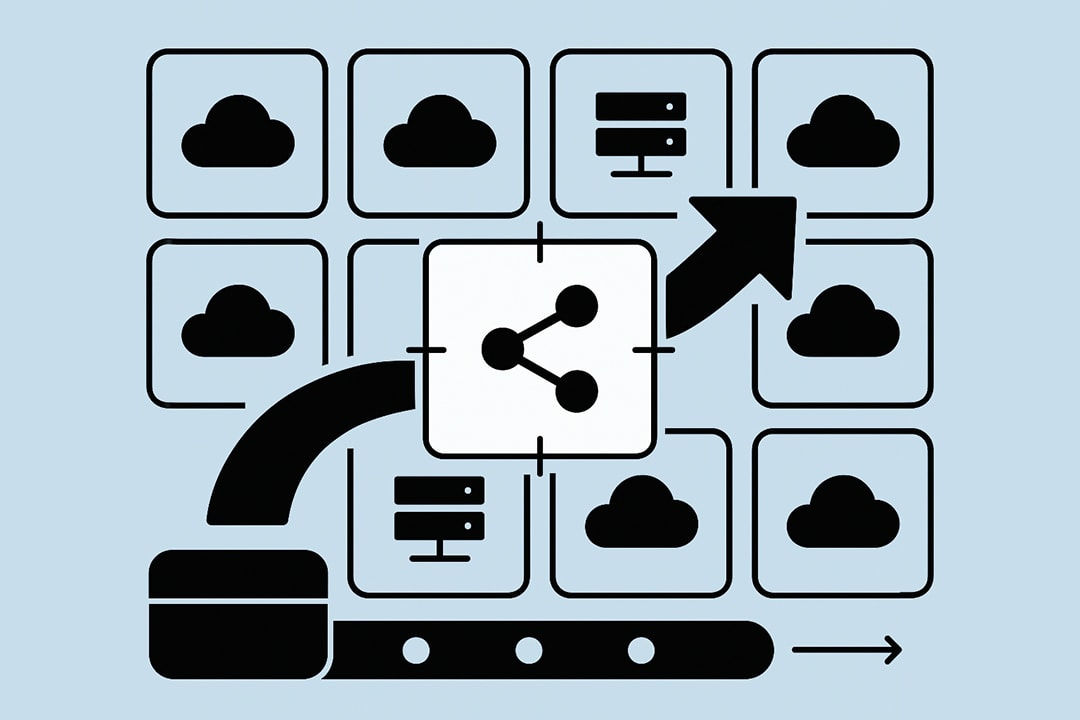How to stay in control of vendor selection as an IT leader
Buyer-first vendor selection: set rules, standardize inputs, prove fit, and lock terms. Streamline the vendor selection process for IT teams.

What “buyer-first” means and why it matters
Buyer-first means you set the pace, scope, and rules of engagement in vendor selection—vendors don’t. You define outcomes and constraints up front, turn them into clear criteria, and ask every vendor for comparable inputs and proof. Demos and pricing come after fit is established, not before. With a platform like TechnologyMatch, you can stay anonymous until you’re ready to engage and always make the first move. Don’t be bothered by sales reps spamming you outreach emails because we know it’s annoying.
Why it matters:
- Less noise, more signal: You avoid endless pitches and focus on vendors that can deliver.
- You control the pace: Since you make the first move, the conversation happens according to you.
- Lower risk: Security, data rights, SLAs, and exit steps are discussed early and captured in writing.
- Faster, cleaner decisions: Standardized questions, side‑by‑side comparisons, and pass/fail checks keep choices objective.
- Stronger negotiations: With evidence from small proofs, you negotiate for value—not just a lower list price.
- Smoother execution: Agreements flow into onboarding checklists, day‑one KPIs, and review cadences.
In short, a buyer‑first approach turns vendor selection into a controlled decision discipline. You surface risks earlier, reduce rework, and sign contracts that reflect reality—especially critical for IT vendor selection.
A practical playbook for buyer-first vendor selection
1) Write a one-page brief
Start vendor selection with a simple, one-page brief. State the problem, the outcome you need, the scope, the budget range, and the timeline. This gives everyone the same target and keeps the vendor selection process focused from the first conversation.
SLAs will become your Holy Grail. List non-negotiables along with data ownership and export steps, privacy terms, and a clean exit. Add 3–5 success KPIs you’ll measure after go-live. These become your initial vendor selection criteria and help you say “no” early.
Include a short question block (SSO method, export formats, incident RCA timeline) and required artifacts (sample RCA, status history, DPA, export sample) and ask every vendor the same basics. Comparable inputs make vendor selection fair and fast.
2) Set roles and decision gates
Assign clear roles before any outreach. Name a single owner, evaluators for tech and security, and approvers for finance and legal. This simple RACI keeps vendor selection moving and avoids last‑minute chaos.
Publish the path. Define stage gates in the vendor selection process: longlist → shortlist → pilot/PoC → award. For each gate, list the evidence you need (e.g., security docs, export sample, pilot results) so decisions are based on proof, not opinions.
Make timing visible. Set target dates for each gate and share them with suppliers. When everyone sees the same roadmap, IT vendor selection stays on pace without rushed shortcuts.
Capture decisions in one place. Record scores, rationale, and approvals as you progress. A lightweight trail makes vendor selection defensible and speeds final sign‑off.
3) Build clear, weighted criteria
Turn needs into a short list of must‑haves, nice‑to‑haves, and deal‑breakers. Keep it practical: security basics, data ownership and export, integration fit, support hours, and SLA targets. This keeps vendor selection focused on what actually protects delivery.
Make evidence mandatory. For each criterion, state the proof you expect (e.g., SOC/ISO letter, export sample, uptime history, RCA example). Comparable proof turns the vendor selection process into an objective exercise, not a debate.
Score simply. Use a 0–5 scale and add light weights so high‑risk areas count more. Publish the model to stakeholders and vendors so everyone knows how choices will be judged in IT vendor selection.
Control changes. If priorities shift, update the criteria and log the reason. Tie the criteria to your pilot plan so every test maps back to a requirement. Clear, weighted criteria cut noise, speed vendor selection, and make approvals easier.
4) Run buyer‑first vendor discovery
Start with your longlist from trusted sources—peers, analysts, curated directories—not cold pitches. Stay anonymous until basic fit is clear. This keeps vendor selection calm and avoids pressure tactics.
Use your must‑haves and deal‑breakers to screen fast, and log why each vendor advances or drops. Comparable checks make the vendor selection process fair and repeatable.
Ask for light proof up front: a security summary, an export sample, a recent status history, and a reference architecture. If basics aren’t available, move on. Proof over pitch speeds IT vendor selection.
Coordinate outreach through one owner and one channel. Share the same brief and questions with every supplier. Tight control reduces noise and keeps vendor selection focused on real contenders.
5) Standardize RFx for equal comparison
Send a short, structured RFI/RFP mapped to your criteria. Ask every vendor the same questions and require the same artifacts (e.g., SLA history, export sample, security summary). Comparable inputs keep vendor selection fair and fast.
Be specific on format and deadlines. Use clear sections (security, data, integration, support, pricing) and simple response templates. This reduces back‑and‑forth and keeps the vendor selection process on pace.
Ask for proof, not prose. Request links or files: sample RCAs, status page history, architecture diagrams, and a support playbook. Evidence turns IT vendor selection from opinion into fact.
Make scoring obvious. Show how answers will be evaluated (0–5 scale) and which items are must‑haves. When vendors know the rules, vendor selection gets cleaner and easier to defend.
6) Risk management and security checks
Screen security, privacy, and data practices early—before demos go deep. Require basics up front: access controls, SSO method, logging, data residency, breach notice windows, and a current cert (e.g., SOC/ISO). Moving these checks earlier keeps vendor selection clean and saves time.
Make it part of the vendor selection process. Treat security and data rights as scored gates, not late checkboxes. Ask for a short security summary, sub‑processor list, and a data export sample. If a vendor can’t provide them, pause IT vendor selection and move on.
Test the essentials in your pilot. Validate sign‑in, audit logs, export formats, and backup/restore steps. Capture findings with screenshots or short notes so they’re easy to compare. This turns risk into facts, not opinions.
Write protections into terms. Convert what you verified into clear language: SLAs, data ownership and export steps, privacy clauses, and exit support. When risk checks lead to written terms, vendor selection stays defensible and practical.
7) Prove it with a focused PoC
Run a small pilot that mirrors real use. Test sign‑in, data import/export, core workflows, and basic reporting with a sanitized data set. Keep scope tight so vendor selection stays fast and the vendor selection process remains on track.
Make results measurable. Set simple pass/fail checks for uptime during the window, response and resolution times, and key performance targets. Validate integration basics (SSO, logs, webhooks) and confirm you can export your data cleanly. This de‑risks IT vendor selection more than any slide.
Staff it right. Ask for vendor engineers in the sessions, not just sales. Time‑box the pilot, hold short daily check‑ins, and track time‑to‑fix for issues. Capture screenshots, logs, and notes so evidence is easy to compare.
Use proof to shape terms. If support lagged, tighten SLAs. If export needed extra steps, write them into the contract. Turning pilot results into clear language makes vendor selection decisions defensible and easier to operate after go‑live.
8) Score objectively and document trade‑offs
Update the scorecard with what you proved—no guesses. Use a simple 0–5 scale, attach the artifacts (RFP answers, pilot logs, SLA history), and let weights do the math. This keeps vendor selection grounded in evidence.
Write a short decision memo. In one page, state why the winner fits, where the gaps are, and how you’ll mitigate them. Link to the scorecard and proof. A clear memo speeds approvals and stabilizes the vendor selection process.
Capture risks and conditions. Note any dependencies you accepted (timelines, features, integrations) and the conditions for success. This creates an audit trail you can carry into IT vendor selection handoffs and onboarding.
Socialize once, consistently. Share the same packet with stakeholders and finalists so everyone sees how the decision was made. Objective scoring and documented trade‑offs make vendor selection defensible—today and at renewal.
9) Negotiate for value, not just price
Lead with terms that protect delivery and negotiate for terms that offer more than just a lower price. Put SLAs, data ownership, export steps, privacy basics, and exit help on the table before you talk discounts. When these are clear, vendor selection stays grounded in value, not sales theater.
Package the price. Tie payments to milestones, add renewal caps, and include support levels and training. Compare packages side by side so the vendor selection process weighs service and outcomes—not just a headline number.
Use proof from the pilot. If support was slow, tighten response and resolution times. If export needed extra steps, document them. Evidence from your tests gives you leverage and keeps IT vendor selection practical.
Write everything down. Turn every promise into plain language in the contract. Clear, measurable terms make vendor selection easier to explain and easier to run after go‑live.
10) Lock it in and operate
Convert promises into clear schedules. Add an SLA schedule, a security/privacy addendum, a data ownership and export schedule, and a support runbook. State who does what and when. Store everything in one place so vendor selection decisions are easy to run day to day.
Handoff to operations with a simple checklist. Cover access, integrations, training, and a success plan. Set day‑one KPIs and a review cadence (e.g., monthly check‑ins, quarterly business reviews). This keeps the vendor selection process connected to real outcomes.
Track and act on results. Log incidents, SLA attainment, and change requests. Use the same scorecard ideas to monitor performance and prepare for renewal early. Clear records make IT vendor selection and renewals faster and calmer.
Feed lessons back into your playbook. Update vendor selection criteria, RFx questions, and pilot scripts based on what mattered in production. Each cycle gets easier—vendor selection becomes a repeatable system, not a one‑off scramble.
Also read: The essential IT vendor selection criteria and checklist
Add structure to your vendor discovery and selection process
Choose a vendor discovery and evaluation tool: Use a platform like TechnologyMatch to identify the right vendors and maintain all your conversations in one place. It keeps vendor selection clear, comparable, and easy to explain. This also speeds the vendor selection process for future buys.
RFx templates: Short, standardized RFI/RFP templates ensure every vendor answers the same questions and provides the same proof. Apples‑to‑apples inputs make IT vendor selection faster and more defensible.
A simple, effective RFP template
Contract and redlining workspace: A basic CLM or shared document workspace with version control keeps terms, edits, and signatures tidy. You move from vendor selection to signed, enforceable agreements without losing context.
Checklist library: Keep reusable checklists for discovery, RFx, pilot, and onboarding. These turn IT vendor selection into a repeatable playbook and reduce rework every time.
Single communication channel: One inbox or project space for all vendor comms prevents drift and missed details. It keeps vendor selection calm, organized, and on pace.
Closing thoughts
A buyer-first approach turns vendor selection from a sales cycle into a disciplined decision you control. Clarity, comparable inputs, proof, and written terms remove guesswork and keep the vendor selection process calm, fast, and defensible.
Run the playbook end to end: one-page brief, roles and gates, clear criteria, buyer-first vendor discovery, standardized RFx, early risk checks, a focused PoC, objective scoring, value-based negotiation, and a clean handoff to operations. The result is fewer wasted demos, lower risk, stronger SLAs and data rights, and smoother onboarding.
Keep it lightweight but consistent. Use simple tools, avoid common pitfalls, and track a handful of signals so IT vendor selection improves each cycle. Start with the brief and scorecard today, everything else becomes easier when you stay in control from day one.
You make the first move, you control the pace with TechnologyMatch
TechnologyMatch doesn’t let vendors spam you with sales pitches. You stay anonymous until you choose to reach out and set the pace of the conversation.
FAQ
What is buyer-first vendor selection and how does it improve the vendor selection process?
Buyer-first vendor selection means you set pace, rules, and evidence requirements. It reduces demo churn, surfaces risk early, and makes the vendor selection process faster and more defensible.
How do I structure the vendor selection process from day one?
Start with a one-page brief, assign roles, and publish decision gates (longlist → shortlist → PoC → award). Standardize RFx and require comparable proof so choices stay objective.
What vendor selection criteria should I use for IT vendor selection?
Prioritize security, data ownership/export, integration fit, SLAs, support, and roadmap fit. Use a weighted scorecard and require evidence (certs, status history, export samples) to keep IT vendor selection objective.
How do I validate vendors before signing a contract?
Run a focused PoC with pass/fail checks tied to your vendor selection criteria. Test SSO, data import/export, key workflows, performance, and support responsiveness; log results and attach artifacts to scoring.
How do I negotiate for value in the vendor selection process?
Lead with SLAs, data rights, and exit terms before price. Package price with milestones, support levels, and renewal caps, and convert promises into clear schedules for smooth post‑award operations.





